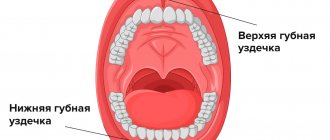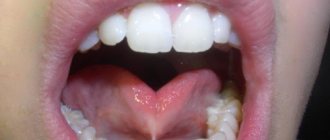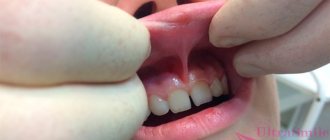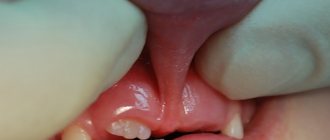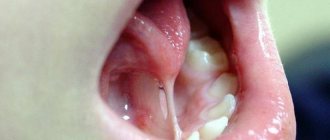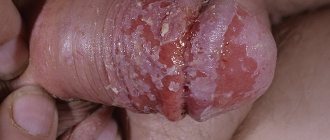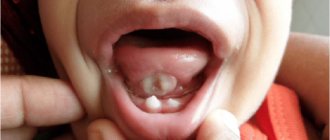Frenules in the oral cavity
When parents talk about the frenulum in the child’s mouth, most often they mean the frenulum of the baby’s tongue, which is quite natural. Problems arise more often precisely because of this oral frenulum: from improper attachment to the breast in the first days of life to speech impairment in the future.
Even dentists give the leading role and importance to this particular frenulum, but this does not mean that the remaining frenulums are unimportant and cannot provoke any pathology.
There are three frenulums in the child's mouth. A frenulum in the oral cavity is nothing more than a small strand of mucous membrane. But, despite this, the frenulum in the oral cavity is of great importance in the life of a child; the child’s nutrition, correct pronunciation of sounds, the condition of the mucous membranes, not to mention the child’s bite and facial aesthetics depend on their condition.
Dentists distinguish between the frenulum of the upper and lower lips and the frenulum of the tongue. Each of them has its own location and performs a number of functions. The frenulum of the lower lip connects the body of the lower jaw and the lower lip; normally, the frenulum is woven into the gum of the lower jaw below the level of the central incisors.
The frenulum of the upper jaw is located according to the same principle as the frenulum on the lower lip. This mucous cord also raises many questions and complaints from parents, since it is primarily associated with the formation of an aesthetic defect in the oral cavity - a gap between the teeth. And the last frenulum in the baby’s mouth is the lingual frenulum, which is woven into the tongue and sublingual space.
Why are short bridles dangerous?
Short frenulum in the mouth can cause many unpleasant consequences. The first of them: the baby cannot attach to the breast correctly, so during feeding it expends a lot of effort, but at the same time receives a smaller volume of milk, and it is simply not enough to satiate. This is sometimes the reason for poor weight gain, but quite often mothers and doctors mistakenly look for the cause in a mythical lack of milk, or some disease, although, first of all, it is necessary to look into the oral cavity and assess the condition of the frenulum.
It is very important for parents to know and remember about this problem, because according to statistics, every 14th child has short frenulum in the oral cavity. If you notice this feature in time, then in the future you can avoid many problems and unpleasant consequences - disturbances in nutrition, speech, bite and, accordingly, facial aesthetics.
For the first time, doctors may notice a short frenulum in the baby’s mouth during the first examination, immediately after birth, and if the fact is confirmed, correction is carried out on the spot. This rule applies to a short frenulum of the tongue, but if the frenulum does not interfere with full natural feeding, the frenulum will not be trimmed in the maternity hospital. Symptoms of a short frenulum may appear later - the child may have difficulty pronouncing some sounds, in which case “treatment” will be carried out later, and, as a rule, in tandem with a speech therapist.
Upper lip frenulum
Even with a simple smile you can see the frenulum of the upper lip, but few people pay attention to it. During a routine examination, the doctor assesses its length; in order to assess the size of the frenulum at home, parents just need to move the baby’s upper lip, and it will become noticeable where exactly the frenulum is woven. In the event that the frenulum is woven between the two front incisors 5–8 mm higher, this is a normal option. If the frenulum is woven below this level, these are obvious symptoms of a shortened frenulum, but the final word always remains with the doctor.
A short frenulum on the upper lip can provoke a violation of the aesthetics of a smile when a gap is formed between the central incisors - a trema, a diastema. It is worth remembering that tremors can be physiological; this period is observed during the period of primary occlusion, when the child’s jaws are preparing for the change of primary teeth to permanent ones. In addition, trems can be pathological, which are formed as a result of some pathology. Treatment of this problem is most often carried out in tandem by a surgeon and an orthodontist.
A short frenulum in a child’s mouth can cause malocclusion, which is formed due to the constant tension of the mucous membrane on the upper jaw and bone tissue. As a result, the front incisors move forward. In addition, such pressure on the mucous membrane provokes inflammation of the mucous membrane - gingivitis. There is a loss of gums, as a result of which the necks of the teeth are exposed and the child develops hypersensitivity of the teeth, and all the conditions are created for the formation of cervical caries.
How does the correction happen?
Treatment of the problem is exclusively surgical, but with one big “BUT”. The frenulum on the upper lip can be corrected only after the eruption of the permanent central incisors, not earlier!!! In some cases, the doctor will recommend adjusting the oral frenulum at the time of the eruption of the permanent lateral incisors - in order to close the gaps between the teeth, such a correction can eliminate orthodontic treatment.
The reason for this ban is very simple. The fact is that during the growth of the jaws, the frenulum on the upper lip can self-correct. That is why there is no point in correcting the frenulum at an earlier age. The correction itself is carried out in a surgical room, under local anesthesia. There are no nerve endings in the mucous cord itself, and therefore the operation is painless; pain relief is necessary when suturing. The operation lasts no more than half an hour and ends with stitches. Thanks to the use of a laser, there is no need for stitches. But there is a certain condition that must be observed after excision of the frenulum: the little one must immediately be attached to the chest.
Methods of lip frenuloplasty
Today, the following methods are used to correct the frenulum of the lower lip:
- Frenotomy (dissection of the frenulum). This technique is used when the frenulum is too narrow and is not attached to the edge of the alveolar ridge. The dissection occurs across the fold.
- Frenectomy (excision of the frenulum). The technique allows you to correct too large a frenulum width. The incision is made along the ridge.
- Frenuloplasty (displacement of the area of attachment of the frenulum).
When using the above methods, sutures are applied with special absorbable threads. The procedure lasts about 15 minutes under local anesthesia and does not cause discomfort.
Laser plastic surgery of the frenulum of the lower lip
Correction of the shape of the frenulum has recently been increasingly performed using a laser. The cost of laser therapy is higher than the price of plastic surgery with surgical instruments, but the procedure is easier to tolerate. The laser beam excises unnecessary tissue, sealing the edges of the wound. The advantage of laser technology for frenulum correction is that there is no need for sutures. The surgical intervention is not accompanied by bleeding, and the recovery period takes a short period of time.
Thus, we can highlight the following advantages of laser plastic surgery of the lower lip frenulum:
- Painless.
- No blood.
- Eliminating the risk of infection (the laser has an antiseptic effect).
- Reduced level of psychological discomfort.
- Fast recovery.
- No need for stitches.
Due to its safety and painlessness, laser plastic surgery is used in children. But adult patients often choose this particular correction technique.
Post-operative care
Complete tissue healing after the procedure occurs in one to two weeks. During this time, the following recommendations should be followed:
- Perform regular, thorough oral hygiene with products prescribed by a specialist.
- Avoid eating hot, hard and sour foods.
- Visit your doctor for a follow-up examination at the time prescribed by the specialist.
- Perform gymnastics to strengthen muscles.
If you follow the above recommendations, the recovery period will pass quickly and without complications.
Frenum of the lower lip
Dentists say that not all babies have a frenulum on the lower lip; it may be completely absent or forked. To study the length of the frenulum, the same technique is used as for studying the frenulum of the upper lip. Normally, the frenulum should be thin and attached in the middle of the body of the jaw. An important condition is that the frenulum of the lower lip must coincide with the center line between the incisors. If these conditions are not met, the bridle is short.
A short oral frenulum interferes with breastfeeding, as the baby cannot properly latch onto the mother's nipple. Fortunately, this situation is quite rare; the most typical manifestation of a short frenulum in the oral cavity is the presence of inflammatory gum diseases in the area of the lower incisors and malocclusion according to the same principle as in the upper jaw.
There are no age restrictions when excision of the mandibular frenulum; usually the mandibular frenulum is diagnosed and corrected at approximately the same time. The principle of the operation is similar to correction on the upper jaw.
Indications for lower lip frenuloplasty
Experts prescribe plastic surgery of the lower lip frenulum if the following indications exist:
- Diastema. A large gap between the lower central pair of incisors that widens over time. Because of this, units can move forward and diverge in different directions. Increased stress on the gums causes periodontitis.
- The need for orthodontic treatment. To install a brace system, it is necessary that the bridle has the correct shape and location.
- Periodontal diseases. A short frenulum may expose tooth roots.
- The need for complete prosthetics. A removable denture will not stay securely in the oral cavity if the frenulum of the lower lip is incorrectly positioned. Often for this reason, plastic surgery is performed on adults.
- Difficulty with breastfeeding. A frenulum that is too short does not allow the baby to perform sucking movements.
- Problems with chewing food. This indication also applies to children. The operation is carried out during the period when solid food begins to be fed so that the child can process food normally and not swallow too large pieces. Thus, the procedure helps prevent digestive problems.
Contraindications to the procedure
Contraindications to plastic surgery of the lower lip frenulum are restrictions that prevent most surgical operations:
- Irregular and improper oral hygiene.
- The presence of malignant tumors in the jaw area.
- Mental illnesses.
- Poor blood clotting.
- Infectious and chronic diseases in acute form.
Why is the correct shape of the frenulum important?
The frenulum of the lower lip of the correct shape plays an important role, performing a number of functions:
- Participation in the formation of correct bite. A frenulum that is too short pulls on the jaw, changing the position of the teeth.
- Ensuring clear pronunciation. Some sounds cannot be pronounced with an incorrectly shaped frenulum of the lower lip. If you do not correct the defect for a long time, it will be difficult to correct your pronunciation later.
- Prevention of oral diseases (gingivitis, periodontitis, caries, inflammation of the frenulum of the lower lip and gums). When the lip is pressed tightly to the gum, the hygiene of this area becomes difficult; bacteria accumulate there, causing oral diseases.
- Creating conditions for comfortable eating.
- Maintaining the performance of facial muscles.
- Providing beautiful lip shape. A short frenulum makes the lips tighter and less plump.
Tongue frenulum
The most complex and insidious frenulum in a child's mouth. It is this frenulum that is able to regulate the movement of the tongue in the oral cavity. Normally, the frenulum is woven approximately in the middle of the tongue, and its length is approximately 8 mm. If the frenulum is attached almost to the tip of the tongue, this is a direct indication for correction.
After birth, the doctor must examine the baby’s oral cavity, which makes it possible to diagnose the pathology. If the frenulum is short, this can lead to difficulties in feeding, and correction is carried out in the maternity ward.
In some cases, the doctor may not notice a short frenulum, but when feeding, the child may experience symptoms that indirectly indicate pathology.
When feeding, the baby makes “smacking” sounds, often drops the breast and tries to rest - the feeding schedule changes, and the number of feedings increases. Babies may be capricious at the breast or even refuse, as a result the child does not gain weight well. Mothers often complain that babies bite their breasts because they cannot get their tongue between the gums and the mother’s nipple.
A short frenulum in the oral cavity can be diagnosed throughout life. In order to make sure once and for all that everything is in order in the child’s mouth, it is necessary to carry out a series of tests. Parents can also do this, although the doctor will most correctly conduct the tests.
The child should be asked to open his mouth and reach his tongue to the roof of his mouth. If the baby performs this operation without any difficulties, there is nothing to fear. But, if the child experiences unpleasant or painful sensations, or the baby is not able to reach the sky, this is an indication for a quick visit to the dentist. Parents should remember that such a test is informative only for children two to three years old.
Only a dentist or speech therapist can confirm shortening of the frenulum of the tongue in children of school and preschool age. Usually, an examination is prompted by a speech disorder in a child, when the child cannot pronounce a certain set of sounds - “r”, “sh”, “sch”, “zh”, “ch”, etc.
How does the correction happen?
There are features of correction depending on the age of the child. In the case of frenulum correction in newborns, which occurs in the maternity ward and with the obligatory presence of the mother, the frenulum is cut using special scissors or a laser, the latter is preferred. There are no nerve fibers in the frenulum itself, but there are many blood vessels. When using a laser, all blood capillaries are closed - there is no bleeding, and there is no need for stitches. A prerequisite is the presence of the mother during the procedure, since immediately after excision of the frenulum, the baby must be attached to the breast. It is at this time that the frenulum returns to normal and possible bleeding stops.
In the case of correction of the tongue frenulum in older children, both surgical and speech therapy treatment can be used. Everything will depend on its length and the age of the child, and on the consequences that this pathology provoked. Parents must clearly remember that the final verdict rests with the dentist, and not with the speech therapist, who can sometimes give false hopes for stretching the oral frenulum using various exercises.
It is the dentist who can assess the damage and clearly predict whether speech therapy treatment is suitable in each specific case. Quite often, dentists advise using complex treatment: surgical dissection of the oral frenulum and the use of speech therapy exercises - this combination gives excellent results.
Frenum of the lip and tongue
Lip frenulum
The attachment of the lips to the jaw is ensured by special folds of the mucous membrane that run along the midlines of the inner surface of the lips.
If the size of the fold is proportional, then the lip completely covers the teeth when they close and has sufficient mobility. However, in some patients the labial frenulum is shortened or attached to the jaw too low. In this case, its functions are impaired. A shortened labial frenulum is a congenital defect, the causes of which have not yet been accurately determined.
While the child is still small, a short frenulum of the lip usually does not cause him any discomfort. This defect does not affect the formation of the facial skeleton, so for the time being it is left without medical intervention. Problems may appear during the period when baby teeth change. If, after the eruption of the upper central incisors, the frenulum of the upper lip becomes wedged between them, then even with straight teeth, an unsightly gap (diastema) will remain between them, which does not decorate the smile. A cosmetic problem is not the only drawback of a shortened lip frenulum. Its low attachment creates an increased load on the teeth, as a result of which the bone tissue in this area becomes thinner over time. This often leads to the development of periodontal disease in older patients.
Correction of such a defect as a shortened frenulum is possible only through surgery. Such an operation is not indicated in all cases; it is usually performed only on the recommendation of an orthodontist. Plastic surgery of the upper lip frenulum is permissible only after complete eruption of the upper lateral incisors.
The frenulum of the lower lip also often becomes a source of dental problems. A short frenulum of the lower lip can cause gum recession, exposing the roots of the mandibular anterior teeth. In addition, a short frenulum of the lower lip provokes periodontal diseases and the occurrence of malocclusions.
The optimal age for correction of the frenulum of the lower lip is 6-7 years. Most often, this procedure must be performed before orthodontic treatment (bite correction). In adults, plastic surgery of the lower lip frenulum is often combined with an operation to deepen the vestibule of the oral cavity before dental prosthetics.
This operation is performed on an outpatient basis, under local anesthesia. The surgeon excises a fold of mucous membrane and then places stitches on it. The operation takes no more than 15-20 minutes, postoperative sutures dissolve on their own. Using a laser scalpel allows you to do without anesthesia, and the healing process is also much faster.
However, you should know that frenuloplasty is only a preparatory stage for orthodontic treatment, since the gap between the teeth will not decrease on its own. Correction of the dentition can begin only after the final resorption of the sutures. Carrying out such an operation at a later age is also possible, but the orthodontic treatment procedure will undoubtedly be longer.
Tongue frenulum
If you lift the tongue upward and slightly move it back, on the lower surface you can clearly distinguish a cord running along the central line from the mucous membrane of the tongue to the very bottom of the mouth and ending almost at the surfaces of the lower incisors. This cord is called the frenulum of the tongue; its normal length in an adult ranges from 27 to 30 mm.
It also happens that the end of the frenulum of the tongue is not located on the mucous membrane, but almost at its tip. If the tongue is stuck out, it barely covers the lower lip; its further advancement is hampered by the shortened frenulum. True, it is not always shortened; sometimes the mobility of the tongue is limited due to improper attachment of the frenulum, but more often it is actually 12-15 mm shorter than normal.
Is the inability to properly stick your tongue out of your mouth really a serious problem that needs to be discussed? Imagine, yes!
The problem of a short frenulum is quite serious; for example, even in infancy it can become an obstacle to normal sucking. The child becomes restless, does not eat enough, is capricious, cries, and loses weight. In such cases, surgery to excise the frenulum of the tongue is performed immediately. Immediately after the operation, the baby is given breastfeeding, which helps develop the tongue and make it more mobile.
A shortened frenulum of the tongue can make itself felt at a later age. In this case, the tongue is located between the teeth, complicating the breathing process and interfering with the pronunciation of a number of sounds. This leads not only to diction disorders, but also to the formation of dental anomalies, which in turn requires bite correction. Moreover, orthodontic treatment requires time and financial costs. Typically, children of primary school age undergo frenulectomy surgery on the recommendation of a speech therapist. After the operation, special gymnastics for the tongue are prescribed, in addition to which the child undergoes a course of treatment from a speech therapist aimed at preventing, and even more often correcting, diction defects.
For adults, a short frenulum of the tongue also causes a lot of trouble. It can significantly interfere with normal chewing of food and wearing removable dentures. But still, tongue frenuloplasty is usually performed much earlier than natural teeth have to be replaced with dentures. Healing of an excised frenulum occurs most quickly in infancy, however, even in primary school, and even in adolescence, such an operation is very effective, and complications in the postoperative period are extremely rare.
